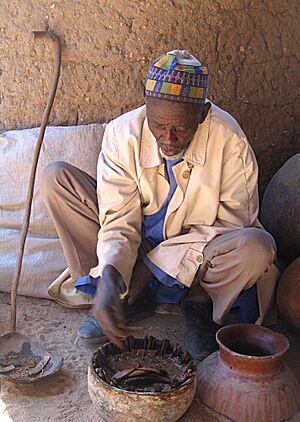Divination facts for kids

Divination is when people try to find out secret information or learn about the future. They do this by looking for special signs or using what they believe are supernatural methods. The word "divine" means to do this, but it's different from the word "divine" meaning something holy or god-like. Many different ways have been used to try and predict outcomes, some of which are listed below.
Divination is a bit different from fortune-telling. Divination is usually more serious and often part of a religious ceremony. It's often about bigger questions or for a community. Fortune-telling is usually more about personal questions or everyday events.
Exploring Types of Divination
People have used many interesting methods to try and understand hidden things or the future. Here are some of them:
- Astrology: This is a way of trying to predict things based on the positions of planets and stars.
- Ailuromancy: This involves trying to get information by watching how cats behave.
- Augury: Ancient Romans used this method, where they tried to predict events by watching the flight patterns of birds.
- Bibliomancy: This is when someone opens a book, often a religious one, at random and reads a passage to find a message or answer.
- Cartomancy: This type of divination uses cards, like regular playing cards, Tarot cards, or other special oracle cards.
- Cheiromancy (also called Palmistry): This is the practice of reading the lines and shapes on a person's palm to learn about their character or future.
- Chronomancy: This method involves deciding if a certain day or time is lucky or unlucky for an event.
- Crystallomancy (also called Scrying): This is when someone looks into a crystal ball, a mirror, or even water to see visions or messages.
- Extispicy: This was a very old and unusual method where people would examine the insides of sacrificed animals to find omens.
- Geomancy: This involves using patterns on the ground or earth. A well-known type is Feng shui, which is about arranging spaces to create good energy.
- Graphology: This is the study of handwriting to understand a person's personality.
- I Ching divination: This is an ancient Chinese method that uses a special book called the I Ching and often involves tossing coins or sticks to get answers.
- Necromancy: This is a very old and often spooky practice of trying to communicate with the dead to gain knowledge.
- Numerology: This method tries to find meaning or predictions based on numbers, often using a person's birth date or name.
- Oneiromancy: This is the practice of trying to understand messages or predictions from dreams.
- Onomancy: This involves trying to learn about a person's future or character based on their name.
- Ouija board divination: This uses a special board with letters and numbers, where people place their fingers on a pointer that moves to spell out messages.
- Phrenology: This was a belief that the shape and bumps on a person's head could reveal their personality traits.
- Pyromancy: This method involves trying to find signs or predictions by observing fire.
- Runecasting: This is a method that uses special symbols called runes, often carved on stones or wood, which are then cast and interpreted.
- Taromancy: This is a specific type of cartomancy that uses a special deck of Tarot cards to gain insights.
Other pages
Images for kids
-
Display on divination, featuring a cross-cultural range of items, in the Pitt Rivers Museum in Oxford, England.
-
Joseph Enthroned. Folio from the "Book of Omens" (Falnama), Safavid Dynasty. 1550. Freer Gallery of Art. This painting would have been positioned alongside a prognostic description of the meaning of this image on the page opposite (conventionally to the left). The reader would flip randomly to a place in the book and digest the text having first viewed the image.
See also
 In Spanish: Adivinación para niños
In Spanish: Adivinación para niños




